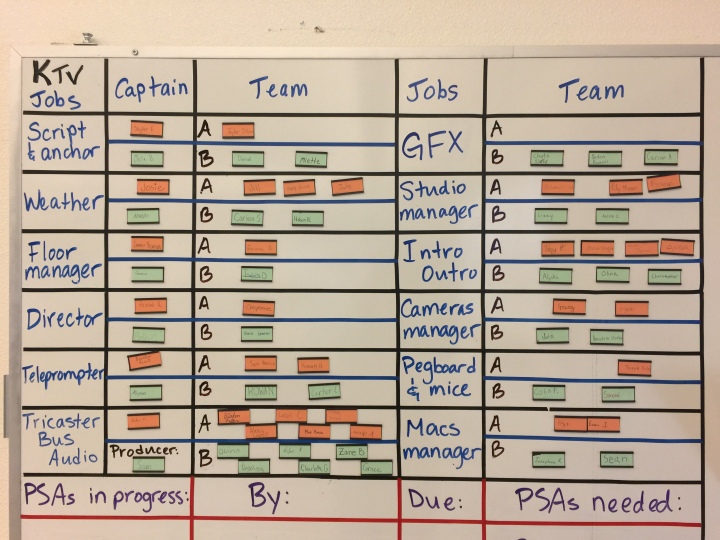There’s nothing quite like the intensity, the chaos, the one-crisis-after-another, the sorry-I-can’t-help-you-go-find-someone-who-can, the exhilaration, jubilation and exhaustion of the first day of production in a middle school broadcast media class.
My brand new group of 7th and 8th graders had met six times in the first couple weeks of school (90 minutes, every other day) and our audience was antsy for a show. Our news program delivers the daily announcements to the staff and students, and at the start of the school year there is a lot of information that students need.

So after just six class periods of training 12- and 13-year-olds to write scripts, create graphics, film and edit video shorts, set up cameras and lights, read from (and pace) tele-prompters, load media onto a TriCaster, manage the audio, direct the anchors, and operate a video bus and TriCaster during filming (which includes green screen technology, switching between four cameras and four student anchors, and incorporating graphics and videos during filming), it was time to get our first show on the air.

Suffice it to say, chaos reigned. The script team struggled with the language of dates (“If I’m writing the script today for a show that airs tomorrow, which day is “today,” which is “tomorrow” and what is “next week”?); the graphics team spent far too much time looking for just the right “labeled for reuse” image for the Icebreaker Dance announcement; the producer couldn’t find camera angles that worked for students under five feet tall and those well over six feet; the floor manager nearly fried her Fitbit chasing down graphics and videos from computers all over the classroom and delivering them to the tech team; the audio team assured us the audio was fine (but, par for the course, it was not fine at all); the bus operator kept switching to the wrong camera at the wrong time; and the TriCaster team fought the never-ending battle of green fuzz around the anchors’ heads.

But when the bell rang for lunch, our first show was finished, uploaded to YouTube and tweeted out on Twitter. And the best part? The kids applauded, slapped high fives, and walked out of the classroom taller, prouder and more confident than they had felt that morning. That show was theirs, warts and all, and they knew that they had a part in its production. (Click below to watch our first show of the 2018-19 school year.)
In my 25+ years as a middle school teacher, I have never seen a class that inspires students to take responsibility, invest in their work, own their efforts and develop confidence like I see in this broadcast media class. And I’m pretty sure this happens in large part because I can’t answer all their questions and I can’t solve all their problems. There are far too many tasks and far too many crises for a teacher to be in charge. No, the smartest move I made in that class was to tell them from day 1, “I will not be able to solve all the problems, so don’t ask. Find someone who can help you.”


It’s not easy to let students struggle, to watch them fail, but when I don’t step in to help, they collaborate, communicate and problem-solve to get that show produced. As their “teacher,” it is an honor and inspiration to step back and watch them take charge.
(For more information on our award-winning broadcast media program, see this post that I wrote for KQED; this series on EducatorInnovator’s The Current; and this video from our 2016 Jack London Award for Innovation in Education from Sonoma State University.)


Reblogged this on Conference on English Leadership (CEL).
Love love love it!